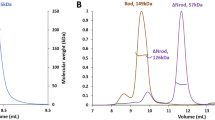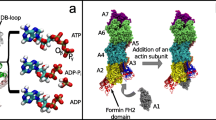Abstract
Intermediate filaments, in addition to microtubules and microfilaments, are one of the three major components of the cytoskeleton in eukaryotic cells, and play an important role in mechanotransduction as well as in providing mechanical stability to cells at large stretch. The molecular structures, mechanical and dynamical properties of the intermediate filament basic building blocks, the dimer and the tetramer, however, have remained elusive due to persistent experimental challenges owing to the large size and fibrillar geometry of this protein. We have recently reported an atomistic-level model of the human vimentin dimer and tetramer, obtained through a bottom-up approach based on structural optimization via molecular simulation based on an implicit solvent model (Qin et al. in PLoS ONE 2009 4(10):e7294, 9). Here we present extensive simulations and structural analyses of the model based on ultra large-scale atomistic-level simulations in an explicit solvent model, with system sizes exceeding 500,000 atoms and simulations carried out at 20 ns time-scales. We report a detailed comparison of the structural and dynamical behavior of this large biomolecular model with implicit and explicit solvent models. Our simulations confirm the stability of the molecular model and provide insight into the dynamical properties of the dimer and tetramer. Specifically, our simulations reveal a heterogeneous distribution of the bending stiffness along the molecular axis with the formation of rather soft and highly flexible hinge-like regions defined by non-alpha-helical linker domains. We report a comparison of Ramachandran maps and the solvent accessible surface area between implicit and explicit solvent models, and compute the persistence length of the dimer and tetramer structure of vimentin intermediate filaments for various subdomains of the protein. Our simulations provide detailed insight into the dynamical properties of the vimentin dimer and tetramer intermediate filament building blocks, which may guide the development of novel coarse-grained models of intermediate filaments, and could also help in understanding assembly mechanisms.











Similar content being viewed by others
References
Alberts B, Johnson A, Lewis J, Raff M, Roberts K et al. (2002) Molecular biology of the cell. Taylor & Francis, New York
Herrmann H, Bar H, Kreplak L, Strelkov SV, Aebi U (2007) Intermediate filaments: from cell architecture to nanomechanics. Nat Rev Mol Cell Biol 8(7):562–573
Wang N, Butler JP, Ingber DE (1993) Mechanotransduction across the cell surface and through the cytoskeleton. Science 260(5111):1124–1127
Wang N, Stamenovic D (2002) Mechanics of vimentin intermediate filaments. J Muscle Res Cell Motil 23(5–6):535–540
Fudge D, Russell D, Beriault D, Moore W, Lane EB et al. (2008) The intermediate filament network in cultured human keratinocytes is remarkably extensible and resilient. PLoS ONE 3(6):e2327
Qin Z, Buehler MJ, Kreplak L (2010) A multi-scale approach to understand the mechanobiology of intermediate filaments. J Biomech 43(1):15–22
Lewis MK, Nahirney PC, Chen V, Adhikari BB, Wright J et al. (2003) Concentric intermediate filament lattice links to specialized Z-band junctional complexes in sonic muscle fibers of the type I male midshipman fish. J Struct Biol 143(1):56–71
Kreplak L, Herrmann H, Aebi U (2008) Tensile properties of single desmin intermediate filaments. Biophys J 94(7):2790–2799
Qin Z, Kreplak L, Buehler MJ (2009) Hierarchical structure controls nanomechanical properties of vimentin intermediate filaments. PLoS ONE 4(10):e7294
Dahl KN, Kahn SM, Wilson KL, Discher DE (2004) The nuclear envelope lamina network has elasticity and a compressibility limit suggestive of a molecular shock absorber. J Cell Sci 117(20):4779–4786
Wilson KL, Zastrow MS, Lee KK (2001) Lamins and disease: Insights into nuclear infrastructure. Cell 104(5):647–650
Aebi U, Cohn J, Buhle L, Gerace L (1986) The Nuclear Lamina is a Meshwork of Intermediate-Type Filaments. Nature 323(6088):560–564
Brenner M, Johnson AB, Boespflug-Tanguy O, Rodriguez D, Goldman JE et al. (2001) Mutations in GFAP, encoding glial fibrillary acidic protein, are associated with Alexander disease. Nat Genet 27(1):117–120
Brown CA, Lanning RW, McKinney KQ, Salvino AR, Cherniske E et al. (2001) Novel and recurrent mutations in lamin A/C in patients with Emery-Dreifuss muscular dystrophy. Am J Med Genet 102(4):359–367
Bonne G, Mercuri E, Muchir A, Urtizberea A, Becane HM et al. (2000) Clinical and molecular genetic spectrum of autosomal dominant Emery-Dreifuss muscular dystrophy due to mutations of the lamin A/C gene. Ann Neurol 48(2):170–180
Broers JLV, Hutchison CJ, Ramaekers FCS (2004) Laminopathies. J Pathol 204(4):478–488
Omary MB, Coulombe PA, McLean WH (2004) Intermediate filament proteins and their associated diseases. N Engl J Med 351(20):2087–2100
Parry DAD, Strelkov SV, Burkhard P, Aebi U, Herrmann H (2007) Towards a molecular description of intermediate filament structure and assembly. Exp Cell Res 313(10):2204–2216
Sokolova AV, Kreplak L, Wedig T, Mucke N, Svergun DI et al. (2006) Monitoring intermediate filament assembly by small-angle x-ray scattering reveals the molecular architecture of assembly intermediates. Proc Natl Acad Sci USA 103(44):16206–16211
Strelkov SV, Herrmann H, Geisler N, Lustig A, Ivaninskii S et al. (2001) Divide-and-conquer crystallographic approach towards an atomic structure of intermediate filaments. J Mol Biol 306(4):773–781
Parry DAD (2006) Hendecad repeat in segment 2A and linker L2 of intermediate filament chains implies the possibility of a right-handed coiled-coil structure. J Struct Biol 155(2):370–374
Strelkov SV, Herrmann H, Geisler N, Wedig T, Zimbelmann R et al. (2002) Conserved segments 1A and 2B of the intermediate filament dimer: their atomic structures and role in filament assembly. EMBO J 21(6):1255–1266
Rafik ME, Doucet J, Briki F (2004) The intermediate filament architecture as determined by X-ray diffraction modeling of hard alpha-keratin. Biophys J 86(6):3893–3904
Luca S, Yau WM, Leapman R, Tycko R (2007) Peptide conformation and supramolecular organization in amylin fibrils: Constraints from solid-state NMR. Biochemistry 46(47):13505–13522
Goldie KN, Wedig T, Mitra AK, Aebi U, Herrmann H et al. (2007) Dissecting the 3-D structure of vimentin intermediate filaments by cryo-electron tomography. J Struct Biol 158(3):378–385
Huang A, Stultz CM (2007) Conformational sampling with implicit solvent models: Application to the PHF6 peptide in tau protein. Biophys J 92(1):34–45
Zhou RH, Berne BJ (2002) Can a continuum solvent model reproduce the free energy landscape of a beta-hairpin folding in water? Proc Natl Acad Sci USA 99(20):12777–12782
Nymeyer H, Garcia AE (2003) Simulation of the folding equilibrium of alpha-helical peptides: a comparison of the generalized Born approximation with explicit solvent. Proc Natl Acad Sci USA 100(24):13934–13939
Lazaridis T, Karplus M (1999) Effective energy function for proteins in solution. Protein Struct Funct Genet 35(2):133–152
Lazaridis T, Karplus M (1997) “New view” of protein folding reconciled with the old through multiple unfolding simulations. Science 278(5345):1928–1931
Best RB, Merchant KA, Gopich IV, Schuler B, Bax A et al. (2007) Effect of flexibility and cis residues in single-molecule FRET studies of polyproline. Proc Natl Acad Sci USA 104(48):18964–18969
Paci E, Karplus M (2000) Unfolding proteins by external forces and temperature: the importance of topology and energetics. Proc Natl Acad Sci USA 97(12):6521–6526
Paci E, Karplus M (1999) Forced unfolding of fibronectin type 3 modules: An analysis by biased molecular dynamics simulations. J Mol Biol 288(3):441–459
MacKerell AD, Bashford D, Bellott M, Dunbrack RL, Evanseck JD et al. (1998) All-atom empirical potential for molecular modeling and dynamics studies of proteins. J Phys Chem B 102(18):3586–3616
Nelson MT, Humphrey W, Gursoy A, Dalke A, Kale LV et al. (1996) NAMD: A parallel, object oriented molecular dynamics program. Int J Supercomput Appl 10(4):251–268
Mucke N, Wedig T, Burer A, Marekov LN, Steinert PM et al. (2004) Molecular and biophysical characterization of assembly-starter units of human vimentin. J Mol Biol 340(1):97–114
Keten S, Buehler MJ (2008) Geometric confinement governs the rupture strength of H-bond assemblies at a critical length scale. Nano Lett 8(2):743–748
Ramachandran GN, Ramakrishnan C, Sasisekharan V (1963) Stereochemistry of polypeptide chain configurations. J Mol Biol 7:95–99
Guzman C, Jeney S, Kreplak L, Kasas S, Kulik AJ et al. (2006) Exploring the mechanical properties of single vimentin intermediate filaments by atomic force microscopy. J Mol Biol 360(3):623–630
Acknowledgments
ZQ and MJB acknowledge support by Air Force Office of Scientific Research (AFOSR) (FA9550-08-1-0321) and National Science Foundation (NSF) (MRSEC DMR-081976). This research was supported by an allocation of advanced computing resources supported by the National Science Foundation (TeraGrid, grant # TG-MSS080030). The authors acknowledge support from the TeraGrid Advanced Support Program. The authors declare no conflict of interest of any sort.
Author information
Authors and Affiliations
Corresponding author
Rights and permissions
About this article
Cite this article
Qin, Z., Buehler, M.J. Structure and dynamics of human vimentin intermediate filament dimer and tetramer in explicit and implicit solvent models. J Mol Model 17, 37–48 (2011). https://doi.org/10.1007/s00894-010-0696-6
Received:
Accepted:
Published:
Issue Date:
DOI: https://doi.org/10.1007/s00894-010-0696-6




